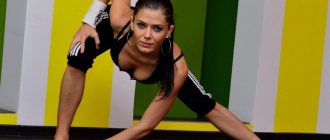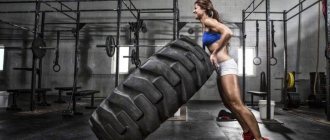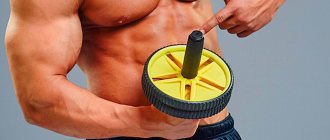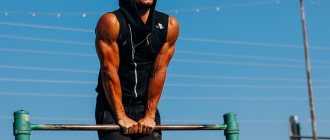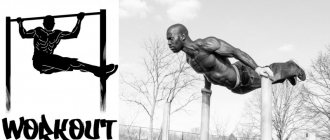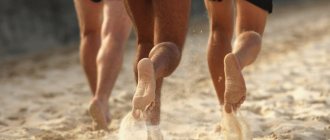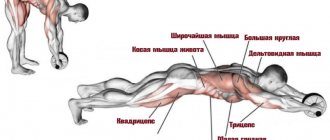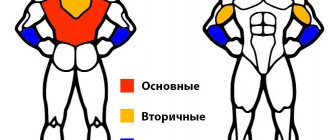- January 28, 2020
- Workouts in the gym
- Maria Klencheva
The wrestler's neck is not made separately from the body. Impressive volumes in this area should be achieved by fully pumping all large muscle groups. This is what the professionals say, and this is how our nature works. A strong neck may be thin, but a “bull” neck is always the result of correct, well-structured training aimed at hypertrophy.
Why shake your neck
The muscles that support the head need to be strengthened regularly. A strong, developed neck copes better with basic functions and ensures normal motor activity when turning and tilting the head. Pumping up this muscle group protects the brain from concussions and the body from sprains and injuries. That is why in many sports, such as martial arts, neck training is done specifically. A wrestling neck is the calling card of a truly strong person!
Even people far from sports will find it useful to perform some of the exercises presented below. And it’s not just that developed neck muscles look beautiful. Regular training serves as an excellent prevention of osteochondrosis, relieves headaches and helps to concentrate.
Strength development
It is one-sided to think that the development of strength in martial arts and martial arts through ordinary strength training, incl. bodybuilding or powerlifting, there is a key to success in performing in the ring. Professional athletes, despite their huge biceps, use a completely different approach to developing the strength and functionality of their bodies. And this is due to the requirements that the chosen sport makes. In the ring, a fighter deals with an opponent who constantly changes body position, moves and resists. You have to constantly push, grab and hold him. Therefore, it would be logical to find a projectile for your training that could replicate such instability and a similar load pattern to the maximum.
When lifting a barbell, advanced lifters hone the technique of performing the bench press, squat, and deadlift down to the smallest detail, slowly adjusting the grip width, body position on the bench, or stance in the power rack before repeating. But in the ring there is a living opponent in front of you and he won’t let you “enter” the throw slowly.
Why doesn't my neck grow?
One of the most important reasons is the lack of heavy basic exercises and strength progression in the training program.
Not all athletes and athletes can boast of a wrestler's neck. The increase in muscle volume in this area occurs mainly through performing basic exercises. But the direct “involvement” of muscle work through isolation exercises is clearly overrated in terms of growth.
This means that it will be unrealistic to pump up the “bull neck” by training specifically with your own weight, light weights or little resistance.
It has been noted that heavy strength exercises provide an increase in body weight, including an increase in volume in the cervical spine. Depending on the execution options, the target muscles can participate indirectly, but even then the resulting load will provoke hypertrophy.
Correcting goose neck can be difficult not only for those who neglect basic exercises and train haphazardly. This process can be affected by diet, environment, genetics, and even stress!
Find reserves within yourself!
- The first thing you need to start self-development is motivation and a goal. Without this, every second workout will end in failure. Anything can serve as a motive: an offender at school or college, bullies in the yard, the presence of a lady who needs to be protected, and so on. Goals should be small, but lead to big things.
- Make every effort to achieve results. Now every day is a battle, but not with an external enemy, but with an internal one. Fear, laziness and other ailments should not interfere with you.
- Despite your best efforts, you will not achieve success if you train without a professional. By the way, a training video can also become a trainer - but don’t grab everything in a row trying to master different techniques. Choose a specific direction: karate, boxing, UFC fights and train.
Warm-up
The neck muscles are easily injured, and the consequences can be very serious. Warm-up should be done with concentration, without sudden movements. Before training, it is better to do light cardio and then move on to joint warm-up.
All variations of loads for pumping the neck come down to three main movements: flexion, extension and rotation. When warming up, these movements are performed without weights or resistance.
- Tilts of the head forward are performed by flexing the neck muscles and bringing the chin to the chest.
- Tilts of the head back are performed similarly due to extension, while the chin moves in the direction from the chest.
- Tilts of the head to the sides are performed using the lateral muscles of the neck when bringing the ear to the shoulder.
- Turning the head to the sides is performed by bringing the chin to the shoulder.
The optimal warm-up duration is 5 minutes, at a comfortable pace, allowing you to do 10-12 repetitions for each position. In this case, it is most convenient to alternate tilting the head back and forth and to the sides, as well as turning the head left and right.
The best moment of the transition from warm-up to training is the feeling of pleasant warmth in the muscles.
Get a strong neck without leaving home
Those who are just starting to exercise their neck muscles should pay attention to the volitional gymnastics of Dr. A.K. Anokhin. All exercises are performed solely through one’s own efforts in a state of maximum muscle tension.
To do this, you need to strongly strain your neck muscles in each of the starting positions for 15-25 seconds. The length of time under load always depends on the level of physical fitness of the trainee.
Performing exercises to strengthen the neck muscles is useful for those who do not yet have basic training to perform strength exercises. It is not necessary to have special equipment or go to a fitness club.
Light resistance with your hands significantly increases the effectiveness of neck training when performing normal bends and turns of the head.
- I. p. - sitting, clasp your hands at the back of your head. Using muscle effort to overcome resistance, tilt your head back.
- I. p. - sitting, place your palms on your forehead. Similarly, overcome resistance by tilting your head forward.
- I. p. - sitting, palm resting just above the ear. Tilt your head left and right, overcoming the resistance of your hand.
You can perform these exercises from a standing position and even lying on the floor or on a bench.
The neck exercise with a ball is simple, effective and safe, with which you can start pumping up your muscles. The only drawback of this exercise is the lack of strength progression. That is, the resistance is determined by such parameters as the size, stiffness and elasticity of the ball. But over time, you can increase the number of repetitions.
It is necessary to place the ball close to the wall at forehead level, and using the muscles of the neck, rhythmically, but without jerking, press it into the surface. Do 3-4 working sets of 12-15 repetitions, then change position and perform the same, placing the ball just above the ear on each side, and then on the back of the head.
Instructions: how to start wrestling
I started practicing judo with an emphasis on the Nevaza section, this is the same ground game at 35, it helped me lose weight and get in shape. The main requirements for judo are speed (timing), so when you are over 30, it is difficult to adapt to such speed, but on the ground, speed is not needed and the anthropometric superiority of the opponent, long arms and greater weight can be reduced to zero. After training for three years, I had a back injury (not associated with sports) but the feeling of euphoria that I received from wrestling was not given by any other sport. And at the age of 40, I returned and chose BJJ because of a back injury, since the main fight is horizontal and there is no compressive load on the spine. What can I advise for those who are planning to study. Find the right coach. I trained with both Brazilian wearers and our guys who promote BJJ; how you progress will depend on the coach. A good coach will not give you any YouTube technique for the next six months, but only the basics and a correct understanding of the tactics and strategy of your fight. Wrestling is a very smart sport, like chess, but the pieces here are finally the body and the space of the mat. You begin to plan the battle several moves ahead - how to take the grab correctly, what position to lure the enemy into, how to attack. Regarding physics, I was relatively trained, but there were others without training, but I’ll say right away that physics is important, and versatile. You need functional (strength) endurance, it needs to be developed. There are also special exercises to develop explosive strength, grip and grips. In my forties, I started with wrestling three times a week and CrossFit or functional work twice a week. When my endurance and strength reached the required level (the desired level is when you can train for an hour and still have 6-7 contractions (roll)), I switched to BJJ 5 days a week and general physical training complexes after each workout for 20-30 minutes, with In this regard, I was not inferior to young athletes in terms of functionality. A guy who was 53 trained with me, he started sports at 50 and he trained 6 times a week, he was like a stone. Sport pit in the form of a prot, BCA is a useful addition. Injury: depends on the culture of teaching and wrestling in the group, partners and your ambitions. If you are being strangled or your arm is broken, you don’t have to try to endure it, you have to give up. The same applies to your partner, the main injuries are in the junior belts; they will break your arm to the end, while the senior belt will simply take you out of the move or correctly fix it while practicing the technique. Injuries such as sore fingers and elbows heal quickly and no one remembers about them. Many girls trained with us, one of them had her nose broken in front of me (she flew into it herself), the second did not give up in competitions and had her arm dislocated, after recovery both returned. I was seriously injured in three years - a torn ligament and meniscus (I returned to the mat after 3 months). a crack on my big toe (returned after removing the cast, a month) and a broken leg (this is rather an exception, which was the first time in our club, non-core dangerous work in the stand) now I have recovered and am waiting for the end of Covid to return to the mat. Socialization: many who come to the fight note that this community resembles a sect. Its own community, its own symbols, jokes, clothing style and other attributes of the subculture. Partying at competitions, which by the way take place in many weight and age categories. Of the 10 who started training, 4 remain after six months, powerful motivation begins to appear when you manage to perform a technique, then you begin to hone it, after a year, it will not be difficult to lure an unprepared but physically stronger opponent into a trap and take him to a painful or suffocating technique until he submits . .But the most important thing is the feeling of physical and emotional release that I did not get anywhere. This is a very smart sport, where in seconds you need to build a decision tree based on the existing starting position and choose the right one, and after a couple of seconds build a new one. I hope my comment will be useful to those who finally decide and start
Bull neck workouts in the gym
Here the temptation to abuse the load often arises. There is a lot of different equipment in the gym, which should be used carefully so as not to break your neck. Instead of overloading the target group and trying to achieve a wrestler's neck by hook or by crook, it is better to create a competent training plan that includes basic strength exercises. Separately, you can include exercises for the neck. It would be logical to shake your neck on shoulder and back day.
Classic exercises such as deadlifts, squats, bench presses, and pull-ups help you gain weight. When these exercises are performed correctly, the neck muscles also receive hypertrophy stress.
You can achieve great results with these exercises if you regularly include them in your training program.
- Shrugs with a barbell or dumbbells while standing. This exercise powerfully pumps one of the largest muscles - the trapezius. Powerful upper trapezius and gives the effect of a wrestler's neck. I. p. - standing, barbell or dumbbells lowered down. It is necessary to lift the shoulders up by contracting the trapezius, linger for a few seconds at the top point, and then return to the starting position.
- Bending and extension on a horizontal bench with your own weight, weights or using a head clamp. Pancakes are most often used as weights, which are placed on the forehead, back of the head or temporal area, depending on the exercise. I. p. - lying on a bench, on your back, stomach or side so that your head, neck and shoulders are suspended. For convenience, first put on a hat for practice or wrap the pancake with a towel. Perform flexions, extensions and head tilts using weights. From a sitting position or in a tilted position, flexion or extension of the neck can be conveniently performed using a head clamp.
- Exercises on a special exercise machine for the neck muscles. The obvious advantage of the block simulator is the predetermined amplitude and uniform load - it does not need to be controlled, which means you can fully concentrate on performing the exercise. If there is no special equipment in the gym, any available means (elastic band, expander) will be used.
content .. 91 92 98 ..
SPECIAL EXERCISES FOR A WRESTLER
They are divided into special preparatory (leading) and simulation.
Special preparatory (leading) exercises include those that, in the nature and structure of movements, have significant similarities with technical and tactical actions. This also includes elements of wrestling, insurance, self-insurance in sambo and the simplest forms of wrestling. These exercises are performed with the aim of developing the necessary physical and volitional qualities, as well as for more successful mastery of complex techniques. They can be carried out without equipment, with equipment (stuffed animal, bag, weights, barbell, etc.), with a partner.
Simulation exercises
Imitation exercises are the performance of wrestling techniques and their elements without equipment and with equipment (a wrestling dummy and a bag).
These types of exercises allow you to master and improve technique and tactics of techniques.
Imitation exercises without implements are recommended to be performed only after the wrestler has mastered the structure of this technique and correctly and clearly imagines its implementation in all details.
Imitation exercises with apparatus are especially widely used in cases where it becomes difficult to repeatedly perform techniques and individual elements with a partner (for example, when repeating throws with deflection multiple times).
But you should not get carried away with practicing techniques with a stuffed animal (bag), since the structure of the technique when performing it with a stuffed animal and with a partner is different.
Imitation exercises are also used to develop speed, agility and flexibility. In addition, exercises performed with apparatus can serve as a means of developing endurance and strength. Thus, by simulating with a relatively heavy dummy such an element of a throw with a deflection as lifting off the mat, the wrestler simultaneously develops the strength of the muscles of the legs and back while improving the technique. Long-term and intensive performance of simulation exercises has a good effect on the development of endurance.
In classes with novice wrestlers and junior athletes, special preparatory (introductory) and simulation exercises are often used in the form of complexes for mastering complex techniques. For examples of such complexes, see page 570.
Wrestlers of senior ranks, in whose training process training takes up relatively little space and who are sufficiently prepared to master complex coordination techniques, perform special preparatory and simulation exercises, mainly for the purpose of further targeted development of the necessary physical qualities, improvement of wrestling techniques and tactics, correction identified deficiencies.
These exercises are mainly used in the second half of morning exercises (training) and in the preparatory part of the lesson (in the warm-up before a fight), as well as at different times in the main part of the classes. During the sports year, a variety of special exercises are used throughout the preparatory and main training periods.
Here are some sample special preparatory (leading) exercises.
Resistance wrestler exercises
The purpose of these exercises is to prepare the wrestler to be able to tense and resist in the various positions found in wrestling. They are performed with a partner and in a group.
Leg exercises
. Standing facing each other, place your hands on your shoulders, raise your straight leg forward until it crosses each other and move your partner’s leg to the side (Fig. 440-a).
Sitting on the carpet (facing each other), rest your hands on the carpet, extend your leg, lift it up until your shins cross and move your partner’s leg to the side (Fig. 440-b). Sitting opposite each other, rest your hands on the carpet from behind. The left leg of both wrestlers is half-bent and rests one foot against the other. Press on your partner’s leg, trying to bend it and straighten yours (Fig. 440-a). The same exercises with two legs (Fig. 440-d).
The wrestlers lie on their backs side by side on their left sides, with their heads in opposite directions, grabbing each other by the arm. Raise both left legs, hook one over the other and try to pull each other so that the partner turns over his head (Fig. 441-a, 6, c).
Hand exercises
. Stand half-turned facing each other, both put their right leg forward, grab it with their right hand, and place the other leg on their thigh. One pushes his outstretched hand away from him, the other resists (Fig. 442-a).
Stand facing each other, feet shoulder-width apart, grasp with both hands. Alternate pushing: bend one partner’s arm, and yield to the partner’s movement with the other. The partner makes opposite movements (Fig. 442-b). Stand on your left knee facing each other. Knees next to each other at right angles. Place the elbow of your right hand on the knee of your leg and grab your partner’s hand. Move your partner’s arm to the side until failure, without removing the elbow from the knee (Fig. 442-c). Stand upright, lying on your hands, legs apart, rest your right shoulder on each other. Push each other beyond a certain line, helping with your hands and feet (Fig. 442-d).
Group resistance exercises
. Wrestlers from one rank join hands and stand facing the wrestlers in the other rank and come close to them. Resting their chests, they try to push each other beyond a certain line. Wrestlers can perform exercises with their backs to each other (Fig. 443-a, b).
Resistance exercises using apparatus
. One of the partners holds the ends of the relay batons. The other takes the other ends and pulls them out in any way (Fig. 444-a).
Sit on the carpet, rest your feet on each other and hold the stick with both hands. Drag your partner towards you (Fig. 444-b).
Tug of war or pole. Removing a medicine ball in any way, standing or lying down (Fig. 445-a, b).
Games with resistance
"Riders' Fight"
Two parties line up along the line. Each party is divided into “riders” and “horses”. "Riders" sit astride "horses". At a signal, the “riders” flock each other off the “horses” (Fig. 446).
Fight in a circle
. Two wrestlers try to push each other out of a circle with a diameter of 3-4 m. Stand on both legs. The position of the hands is arbitrary.
"Cockfighting".
The wrestlers stand opposite each other on one leg, with their hands behind their backs. Jumping and pushing each other with their shoulders, they try to knock their partner onto both legs (Fig. 447).
Medicine ball basketball
. Two teams of 5-8 people. Ball weight 5 kg. They play on the carpet. You can run with the ball any number of steps and throw the ball to your partners. You can take the ball in any way, trying to knock your opponent onto the carpet. The ball must be pressed to the carpet in a specially marked place.
Fight for girth
. The essence of the fight is to be the first to grab your partner’s torso from the front and join your hands on the back.
Fight for capture
. Be the first to grab your partner's wrist, or leg, or neck.
content .. 91 92 98 ..
Wrestling exercises
How do wrestlers strengthen their necks, literally a vital area that allows them to last longer in the ring? They have their own methods of pumping this muscle. Special exercises are more dangerous because they are intended to train physically trained people. An example is the famous wrestling neck bridge, which is ideally performed without the use of hands. However, it can also be done in a lightweight version, which is suitable for almost everyone.
It’s worth seeing at least once how wrestlers shake their necks. A neck like a rhinoceros can be achieved using the exercises shown in the video above.
